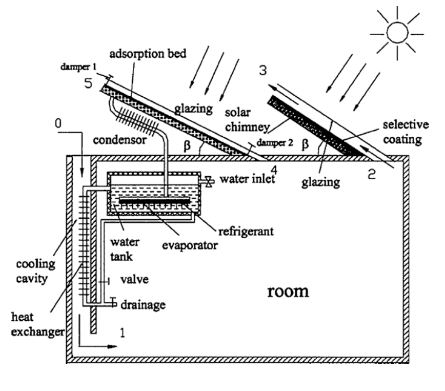Application of Evaporative Cooling in the Building Ventilated by a Solar Chimney
Keywords:
Moist air, Solar induced ventilation, Water spraying system, Water vapor contentAbstract
Over the last two decades, the interest in natural ventilation in buildings has been revived because of the growing awareness of greenhouse gas emission and the need for an efficient passive ventilation system as part of a building. In this respect, solar chimney is a promising solution. In the hot-dry climate, solar chimney has been widely studied to use with a water evaporating system to reduce air and surface temperatures in the buildings. In the hot-humid climate, several applications of solar chimney with indirect evaporative cooling were reported. Successful results were shown in air temperature reduction to meet human thermal comfort. The effect of incorporating the evaporative cooling on air velocity, volume flow rate, relative humidity and air temperature are reviewed in this study. In addition, the mathematical modelling of this integrating system are discussed.
Downloads
References
Ansys, I. (2013). ANSYS fluent theory guide. Pennsylvania: USA.
Cengel, Y. A. (2004). Heat transfer: A practical approach. Singapore: McGrawHill.
Chungloo, S., & Limmeechokchai, L. (2007). Application of passive cooling systems in the hot and humid climate: The case study of solar chimney and wetted roof in Thailand. Building and Environment, 42(9), pp. 3341- 3351.
Chugloo, S., & Pichaisak, M. (2011). A study of the solar chimney for heat protection in a hot and humid climate.Thammasat International Journal of Science and Technology, 16(4), 8-19.
Cuce, P. M., & Riffat, S. (2016). A state of the art review of evaporative cooling systems for building applications. Renewable and Sustainable Energy Reviews, 54, 1240- 1249.
Dai, Y. J., Sumathy, K., Wang, R. Z., & Li, Y. G. (2003). Enhancement of natural ventilation in a solar house with a solar chimney and a solid adsorption cooling cavity. Solar Energy, 74(1), 65-75.
Gan, G. (2010). Simulation of buoyancy-driven natural ventilation of buildings-Impact of computational domain. Energy and Buildings, 48(2), 1290-1300.
Heidarinejad, G., Bozorgmehr, M., Delfani, S., & Esmaeelian, J. (2009). Experimental investigation of two-stage indirect/direct evaporative cooling system in various climatic conditions. Building and Environment, 44(10), 2073-2079.
Jafari, A., & Poshtiri, A. H. (2017). Passive solar cooling of single-storey buildings by an adsorption chiller system combined with a solar chimney. Journal of Cleaner Production, 141, 662-682.
Katarzyna, G. F., & Andrzej, G. (2012). Effect of wind on stack ventilation performance. Energy and Buildings, 51, 242–247.
Khanal, R., & Lei, C. (2015). A numerical investigation of buoyancy induced turbulent air flow in an inclined passive wall solar chimney for natural ventilation. Energy and Buildings, 93, 217–226.
Lei, Y., Zhang, Y., Wang, F., & Wang, X. (2016). Enhancement of natural ventilation of a novel roof solar chimney with perforated absorber plate for building energy conservation. Applied Thermal Engineering, 107, pp. 653-661.
Maerefat, M., & Haghighi, A. P. (2010). Natural cooling of stand-alone houses using solar chimney and evaporative cooling cavity. Renewable Energy, 35(9), 2040-2052.
Marrero, T. R., & Mason, E. A. (1972). Gaseous Diffusion Coefficients. Journal of Physical and Chemical Reference Data, 1(1), 3-118.
Mehran, R., Kalantar, V., Ali, A. D., & Ahmadreza, K. F. (2015). Empirical investigation of the cooling performance of a new designed Trombe wall in combination with solar chimney and water spraying system. Energy and Buildings, 102, pp. 45-57.
Raman, P., Mande, S., & Kishore, V. V. N. (2001). A passive solar system for thermal comfort conditioning of buildings in composite climates. Solar Energy, 70(4), 319-329.
Sompop, P., Jongjit, H., Joseph, K., & Belkacem, Z. (2009). Investigation on the application of solar chimney for multi-storey buildings. Renew Energy, 13(12), 2545–61.
Sudprasert, S., Chinsorranant, C., & Rattanadecho, P. (2016). Numerical study of vertical solar chimneys with moist air in a hot and humid climate. International Journal of Heat and Mass Transfer, 102, 645-656.
Touma, A. A., Ghali, K., Ghaddar, N., & Ismail, N. (2016). Solar chimney integrated with passive evaporative cooler applied on glazing surfaces. Energy, 115(1), 169-179.
Wei, D., Qirong, Y., & Jincui, Z. (2011). A study of the ventilation performance of a series of connected solar chimneys integrated with building. Renewable Energy, 36(1), 265-271.
Xuan, Y. M., Xiao, F. Niu, X. F., Huang, X., & Wang, S. W. (2012). Research and application of evaporative cooling in China: A review (I) – Research. Renewable and Sustainable Energy Reviews, 16(5), 3535-3546.
Zamora, B., & Kaiser, A. S. (2010). Numerical study on mixed buoyancy-wind driving induced flow in a solar chimney for building ventilation. Renewable Energy, 35(9), pp. 2080-2088.

Downloads
Published
How to Cite
Issue
Section
License

This work is licensed under a Creative Commons Attribution-NonCommercial-NoDerivatives 4.0 International License.











